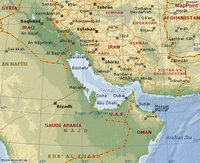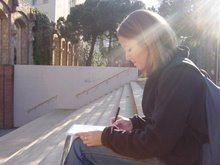
Located on the Persian Gulf coast, the city of Dubai, part of the United Arab Emigrates, is an area of vast wealth and prosperity. It is home to one of the hottest construction markets, and to some of the most known upcoming architectural projects, including SOM's design for the world's tallest tower. The lifestyle of success experienced by many in this region brings about the desire for utopia type communities. In a similar plan design as the Ocean City by Kikutake, the developer Nakheel Development has proposed a masterplan composed of fourteen developments to expand private and commercial mixed use development, increase the region's coastline, and ultimately integrate the sea with the desert.
The illustration below shows the Nakheel Development Masterplan.

Some of the major developments in the plan include:
1. The Arabian canal, an 80 km long manmade canal
2. Palm Jumeriah, contains the Trump tower and a $1.2 billion dollar hotel
3. Palm Deira, the largest mandmade island in the world
4. The World, a development of 300 islands in the shape of the continents randing from $10-$45 million per island
These two images illustrate the Palm Deira and Palm Jumeriah concepts.
 These projects are on
These projects are on  the Mega scale in terms of cost and size. In the Palm Jumeriah project alone, 94 million cubic meters of sand was used, equivalent to a third of the amount of earth used for the 6700 km span of the Great Wall of China. First originating from the idea to increase beachfront, the land reclamation project and the development of the reclaimed land has doubled the shoreline of Dubai by creating 520 km of new shoreline. The amount of new shoreline is almost the same distance as the North Carolina and South Carolina coast.
the Mega scale in terms of cost and size. In the Palm Jumeriah project alone, 94 million cubic meters of sand was used, equivalent to a third of the amount of earth used for the 6700 km span of the Great Wall of China. First originating from the idea to increase beachfront, the land reclamation project and the development of the reclaimed land has doubled the shoreline of Dubai by creating 520 km of new shoreline. The amount of new shoreline is almost the same distance as the North Carolina and South Carolina coast.The idea of land reclamation project on a large scale is becoming a reality. Other large scale reclamation projects include Holland, Florida, and Osaka, Japan. If money is not an issue, land reclamation could greatly enhance many coastal cities in the United States allowing for growing populations and demand for waterfront property. The wealth and standard of living in the United States is reaching towards this direction. In comparison, the properties on Palm Jumeriah are 4100 sq ft houses that sell for about $1 million. Think of the possibilities with new forms or few limitations on the forms generated by land reclamation. How could this process become a significant part of urban design? Is it currently economical in places other than the Arab world?
The proposal is of a significantly large scale in comparison to other cities, such as Charleston, South Carolina in the United States, and Barcelona, Spain. The illustrations below show the insertion of one of the palm islands to the existing cities.



2 comments:
very nice. a link to the SOM tower and showing the comparison in Charleston, Barcelona and/or Genoa would be helpful, as the assignment asks to make some relationship to the home bases. it will come back later as well.
better. wondering also about the amount of dirt that was displaced. where is the hole? can you make one? does that become something?
Post a Comment